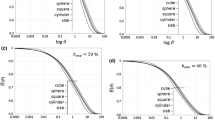Abstract
Part 3 of the present series gives the prediction formulae for the average compliance function in the cross-section of a specimen exposed to drying at constant temperature. The formulae describe the additional creep due to drying by means of the shrinkage function, which automatically introduces the consequences of diffusion theory, such as the dependence of creep on cross-section thickness and shape. The prediction formulae are compared with 19 different data sets from the literature, which reveal relatively good agreement, better than that with previous models. The main source of error is insufficient knowledge of the effect of mix composition and concrete strength. It is advisable to avoid this error by carrying out short-time measurements whenever possible.
Resume
Dans le troisième volet de cette série, on présente les formules de prédiction pour la fonction de compliance moyenne dans la section transversale d’une éprouvette soumise au séchage à température constante. Les formules décrivent le fluage additionnel causé par le séchage au moyen de la fonction de retrait qui introduit automatiquement les aboutissements de la théorie de diffusion, tels ceux qui font dépendre le fluage de l’épaisseur et de la forme de la section transversale. On compare les formules de prédiction à 19 séries de données prises dans la littérature, qui présentent une assez bonne concordance, supérieure à celle obtenue avec les modèles précédents. La source principale d’erreur réside dans une connaissance insuffisante du dosage et de la résistance du béton. On conseille d’éviter cette erreur en effectuant des mesures à court terme chaque fois que c’est possible.
Similar content being viewed by others
References
Bažant, Z. P., ‘Material models for structural creep analysis’, in ‘Mathematical Modeling of Creep and Shrinkage of Concrete’, edibed by Z. P. Bažant (Wiley, Chichester and New York, 1988) pp. 99–215.
Bažant, Z. P. and Chern, J. C., ‘Concrete creep at variable humidity: constitutive law and mechanism’,Mater. Struct. 18(103) (1985) 1–20.
Bažant, Z. P. and Panula, L., ‘Practical prediction of time-dependent deformations of concrete’, Parts I and II:ibid. 11(65) (1978) 307–328. Parts III and IV:ibid. Mater. Struct. 11(66) (1978) 415–434, Parts V and VI:ibid. Mater. Struct. 12(69) (1979) 169–183.
Bažant, Z. P. and Kim, J.-K., ‘Improved prediction model for time-dependent deformations of concrete: Part 2— Basic creep’,ibid. 24 (1991) 409–421.
Bažant, Z. P., Kim, J.-K. and Panula, L., ‘Improved prediction model for time-dependent deformations of concrete: Part I—Shrinkage’,ibid. 24 (1991) 327–345.
Simenov, I. and Bozhinov, G., ‘Some features of the structure of cement stone influencing the creep mechanism of concrete’, inProceedings of International Conference on Mechanical Behaviour of Materials, Kyoto, Japan, 1972, Vol. IV, pp. 262–266.
Bažant, Z. P. and Wang, T. S., ‘Practical prediction of cyclic humidity effect in creep and shrinkage of concrete’,Mater. Struct. 18(106) (1985) 247–252.
Hansen, T. C. and Mattock, A. H., ‘Influence of size and shape of member on the shrinkage and creep of concrete’,ACI J. 63 (1966) 267–290.
Hummel, A., Wesche, K. H. and Brand, W., ‘Der Einfluss der Zementart, des Wasser-Zement-Verhältnisses und des Belastungsalters auf das Kriechen von Beton’, Deutscher Ausschuss für Stahlbeton, Heft 146 (Ernst, Berlin, 1962) pp. 1–58.
Keeton, J. R., ‘Study of creep in concrete’, Technical Reports R333-1, R333-II, R333-III (US Naval Civil Engineering Laboratory, Port Hueneme, California, 1965).
Lambotte, H. and Mommens, A. L., ‘L’évolution du retrait du béton en fonction de sa composition et de l’âge’, Technical Report, groupe de travail GT22 (Centre national de recherches scientifiques et techniques et pour l’industrie cimentière. Bruxelles, 1976), and privately communicated unpublished data (1978).
L’Hermite, R. G., Mamillan, M. and Lefévre, C., ‘Nouveaux résultats de recherches sur la déformation et la rupture du béton’,Ann. Inst. Techn. Bâtiment Trav. Publics 18(207–208) (1965) 323–360; see also International Conference on the Structure of Concrete (Cement and Concrete Association, London, England, 1968) pp. 423–433.
L’Hermite, R. G. and Mamillan, M., ‘Influence de la dimension des éprouvettes sur le retrait’,ibid. 23(270) (1970) 5–6.
Maity, K. and Meyers, B. L., ‘The effect of loading history on the creep and creep recovery of sealed and unsealed plain concrete speciments’, Report No. 70-7, NSF Grant GK-3066 (Department of Civil Engineering, University of Iowa, Iowa City, 1970).
McDonald, J. E., ‘Time-dependent deformation of concrete under multiaxial stress conditions’, Technical Report C-75-4 (Concrete Laboratory, US Army Engineering Waterways Experiment Station, Vicksburg, Miss., 1975).
Mossiossian, V. and Gamble, W. L., ‘Time-dependent behavior of non-composite and composite prestressed concrete structures under field and laboratory conditions’, Structural Research Series No. 385, Illinois Cooperative Highway Research Program, Series No. 129 (Civil Engineering Studies, University of Illinois, Urbana, 1972).
Rostasy, F. S., Teichen, K.-Th. and Engelke, H., ‘Beitrag zur Klärung des Zusammenhanges von Kriechen und Relaxation bei Normal-beton’, Amtliche Forschungs—und Materialprüfungsanstalt für das Bauwesen, Heft 139 (Otto-Graf-Institut, Universität Stuttgart, Strassenbau und Strassenverkehrstechnik. 1972).
Troxell, G. E., Raphael, J. E. and Davis, R. W., ‘Long-time creep and shrinkage tests of plain and reinforced concrete’,Proc. ASTM 58 (1958) 1101–1120.
York, G. P., Kennedy, T. W. and Perry, E. S., ‘Experimental investigation of creep in concrete subjected to multiaxial compressive stresses and elevated temperatures’, Research Report 2864-2 to Oak Ridge National Laboratory (Department of Civil Engineering, University of Texas. Austin, June 1970); see also ‘Concrete for Nuclear Reactors’, American Concrete Institute Special Publication No. 34 (1972) pp. 647–700.
Bažant, Z. P. and Chern, J. C., ‘Strain-softening with creep and exponential algorithm’,J. Engng Mech. ASCE 111 (EM5) (1985) 391–451.
Idem, ‘Strain-softening thermal and shrinkage strains in concrete’,ibid. 113(10) (1987) 1493–1511.
Author information
Authors and Affiliations
Rights and permissions
About this article
Cite this article
Bažant, Z.P., Kim, JK. Improved prediction model for time-dependent deformations of concrete: Part 3-Creep at drying. Materials and Structures 25, 21–28 (1992). https://doi.org/10.1007/BF02472209
Issue Date:
DOI: https://doi.org/10.1007/BF02472209




